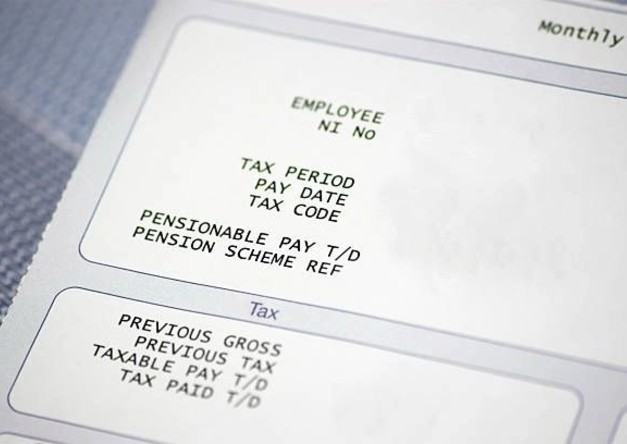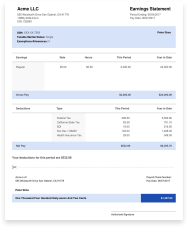Why Are Pay Stub Codes and Abbreviations Important?
By Jaden Miller , April 15 2025

A pay stub provides a breakdown of all your earnings as an employee. It helps you see how your earnings, deductions, and taxes are calculated. You’ll also get to know the amount you eventually take home. A pay stub is definitely an important tool as it helps you manage your finances effectively.
There are, however, certain codes and abbreviations that may confuse you. Many employees don’t know what these abbreviations mean or how to break them down.
This article discusses the common pay stub codes and abbreviations. We’ll discuss all you need to know about these payroll abbreviations. This will help you understand your paycheck better.
Why Pay Stub Codes and Abbreviations Are Important
Payroll codes and abbreviations are necessary for keeping employee payment records organized. They make it easy to categorize employee payroll details. This then ensures that your income is processed accurately. They also help to reduce errors in your pay stub and ensure that you have clear records every pay cycle.
Your Earnings Payroll Codes Explained
An employee's earning section shows details about your earnings, wages, and salary. It explains everything that you earn.
Some earning codes include:
-
Gross- Gross Pay: Refers to your total salary or earnings before any deductions are made. It is the total amount of money that you earn in a pay period.
-
Net- Net Pay: This refers to the final take-home amount. It is what remains after all your deductions are made.
-
Reg Pay- Regular Pay: Regular pay is used for employees who work hourly. This shows their hourly rate for every pay period.
-
CNT Pay- Contract Pay: Refers to an employee’s fixed salary. It is contained in your employment contract when you’re being employed.
-
Hol- Holiday Pay: This refers to the payment that is given to employees for holidays.
-
YTD- Year-To-Date: This shows how much an employee has been paid since the beginning of the year up to the current date.
-
PTO- Paid Time Off: This includes all leaves that are usually paid for. They include days you’re sick or on vacation, as well as personal leave.
Tax Deductions Payroll Codes Explained
These abbreviations are used to show the different tax deductions taken from an employee's paycheck. They include their federal, state, and local tax withholdings. These are taxes that you must pay because you’re required. With these codes, you will be able to know where your income goes.
-
Fed- Federal Income Tax: This refers to the federal income tax that is deducted from your wages. You can also see them as FWT (Federal Withholding Tax), FIT, or FITW (Federal Income Tax Withholding) on your pay stub. It goes directly to the IRS.
-
St Tax- State Tax: This deduction refers to your state income tax. This tax depends on the state you work in, and it doesn’t apply to every employee. You can also see this as SIT (State Income Tax) or SWT (State Withholding Tax).
-
FICA- Federal Insurance Contributions Act: This deduction is made for employees’ Social Security and Medicare.
-
FICA/MT- Medicare: This refers to your FICA tax that is specifically for Medicare. It represents 1.45% of your gross earnings. However, if you earn above a certain amount, you may have to pay an additional Medicare tax.
-
FICA/SS- Social Security: This refers to the Social Security tax you pay. It represents 6.2% of your gross earnings.
Pre-Tax Deductions Payroll Codes Explained
Pre-tax deduction is what is withheld from your paycheck before you calculate your taxes. These are the deductions that reduce your taxable income as an employee.
Some of the common pre-tax payroll codes you might see on your pay stub include
-
FSA- Flexible Spending Account: This refers to an account created so that you can save money for your medical expenses.
-
HSA- Health Savings Account: This account is similar to an FSA. However, HSA is for high-deductible health plans. You can use this to settle medical expenses that are not fully covered by insurance.
-
401(k): This code refers to the money that companies provide for employees' retirement plans. It’s a pre-tax option that increases your savings and lowers your taxable income.
-
IRA- Individual Retirement Account: It refers to an account that you create on your own to plan for your retirement.
-
MED / INS- Medical Insurance Contributions: This refers to all your medical insurance contributions. It’s a pre-tax that you can use to pay for your health plan premiums.
-
VIS- Vision Insurance: This deduction covers employees’ vision insurance. Depending on which plan you choose, it includes vision expenses like eye exams, contact lenses and glasses.
-
DEN- Dental Insurance: is the pre-tax amount you pay for dental care services. It includes dental services like checkups, cleanings, and procedures.
-
HCR- Healthcare Reimbursement: This is the amount you’re refunded for your medical costs. It is usually given back as reimbursement after you've already paid for them.
-
STD / LTD- Short-Term Disability and Long-Term Disability Insurance: These plans provide employees with income protection. This is if they’re unable to work or are temporarily or long-term disabled.
Understanding Your Post-Tax Deductions Payroll Codes
Post-tax deductions are the taxes that are usually deducted from your paycheck after your taxes have been applied. Unlike pre-tax deductions, these taxes don’t reduce your taxable income. Instead, they refer to obligations that you must pay. For example, student loans, child support, or even certain retirement plans.
Some post-tax deductions codes include:
-
Garn / Garn%- Wage Garnishment and Garnishment %: This refers to the amount of your paycheck that pays some legal obligations. It can be payment for alimony, debts, or unpaid fines.
Garnishment %, on the other hand, is still a garnishment, but this is only a percentage of your paycheck. For example, child support or tax liens could take up to 25% of your wages.
-
R401- Roth 401k: This refers to the contributions to your Roth 401(k) retirement plan.
-
UD- Union Dues: This refers to the deductions you make to support the labor unions that you’re a member of. Usually, this takes around 1–2% of your gross pay and is completely voluntary.
-
CHD SU - Child Support: This is any child support that you have to pay, taken from your paycheck. It may either be a fixed amount or is based on your income.
-
StdnLoan- Student Loan: It refers to deductions made to repay your student loans. These payments are automatically taken from your salary, depending on your repayment agreement.
-
TX Levy / IRS Levy - Tax Levy: This is the levy the IRS takes directly from your paycheck to pay your owed taxes.
Final Thoughts
Payroll codes and abbreviations on your pay stubs may be tricky for you at first. However, it’s much easier to understand once you know each pay stub abbreviation meanings. The key is to recognize the different categories of the payroll codes. You’ll also want to differentiate between your earnings, tax, pre-tax, and post-tax deduction codes on your pay stub. Each code has its specific meaning. Understanding and paying attention to them helps your paycheck make more sense. You can then read and manage your pay stub more effectively.
Use our pay stub generator today to create your pay stub. This is also a great way to understand pay stub codes and abbreviations better! We have templates that clearly organize every section of a regular pay stub. This helps to simplify payroll codes with minimal effort. Our tool is what you need. Get started with us today!Similar Articles
We’ve helped numerous individuals and businesses create professional documents! Create yours today!










